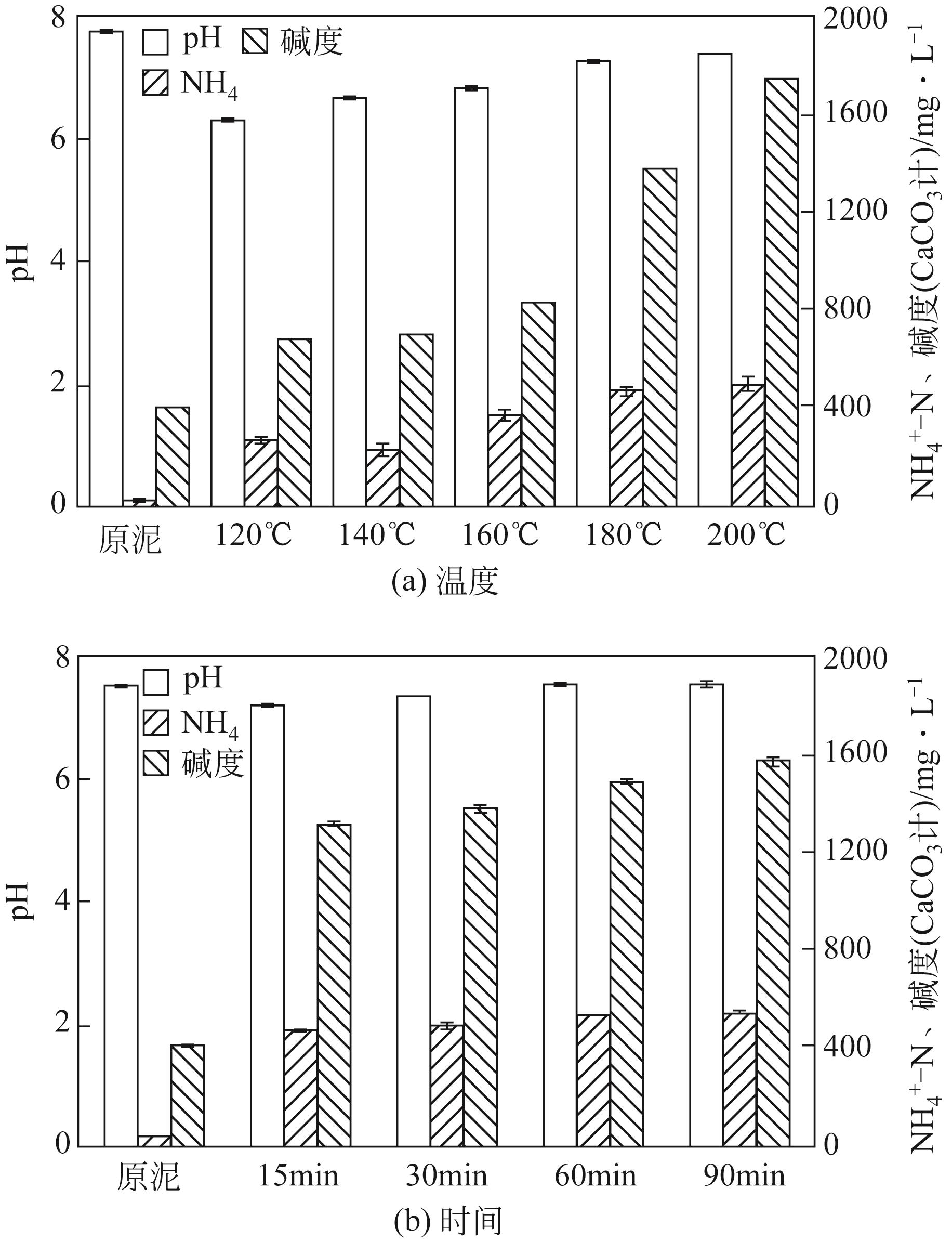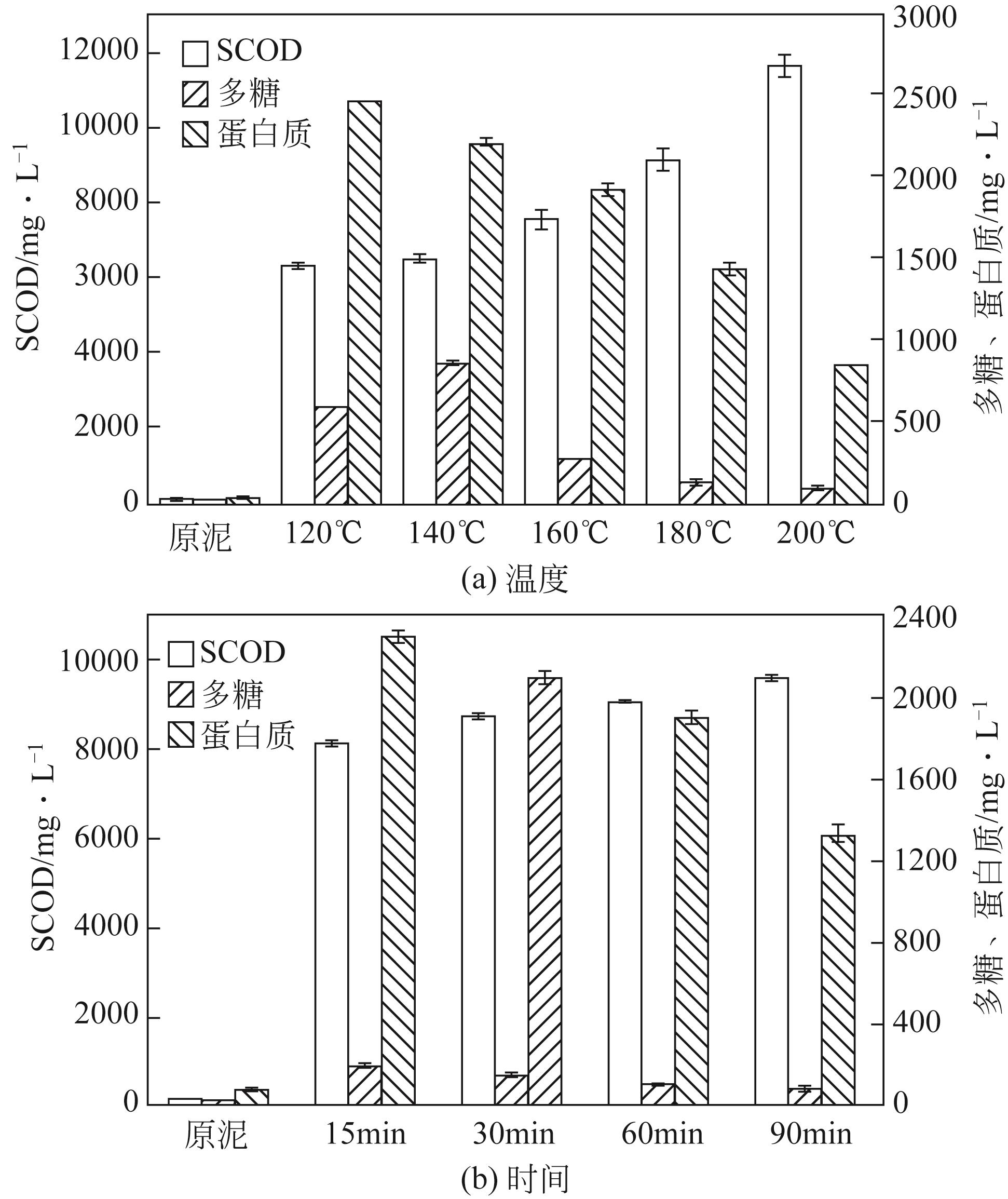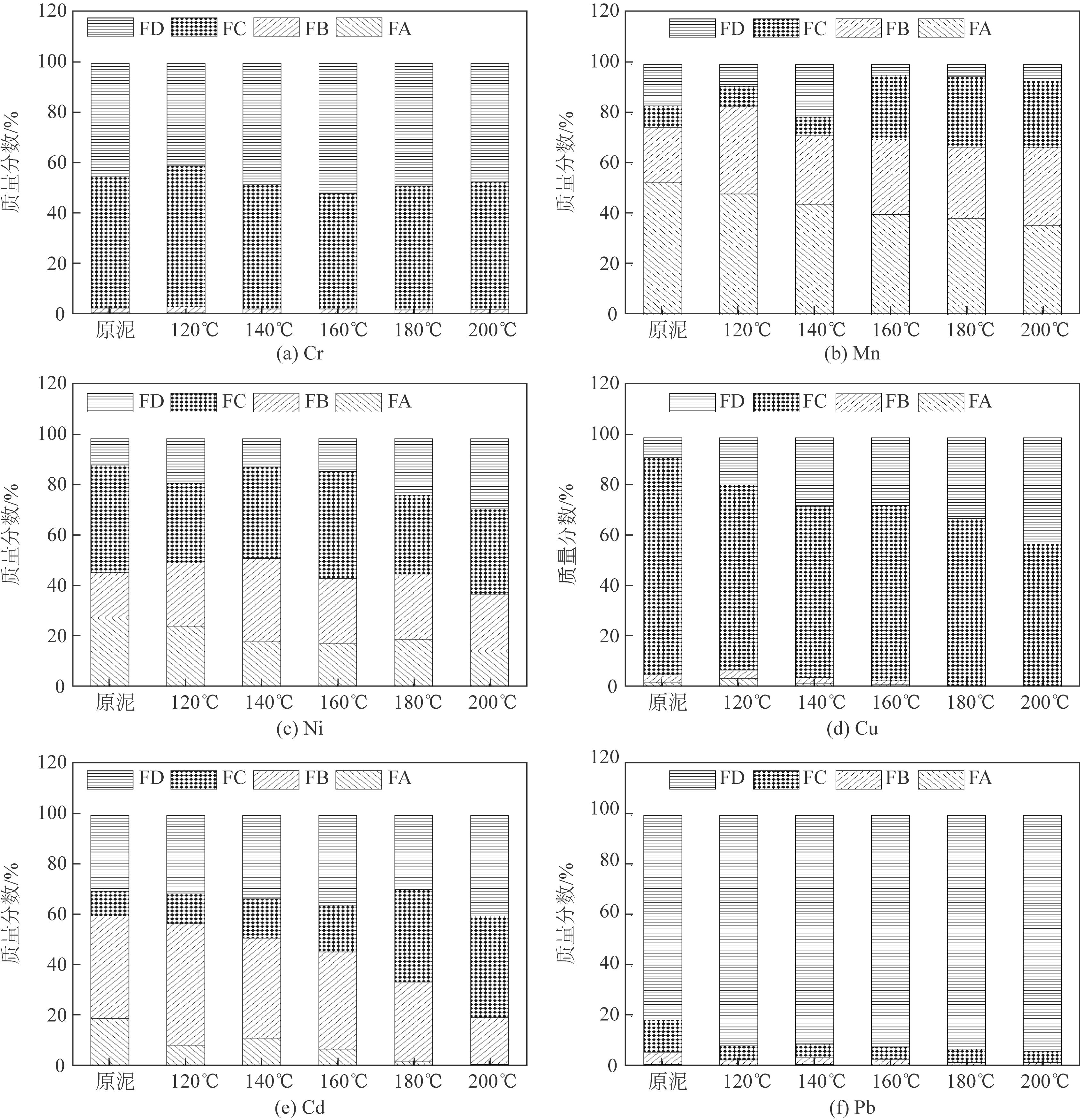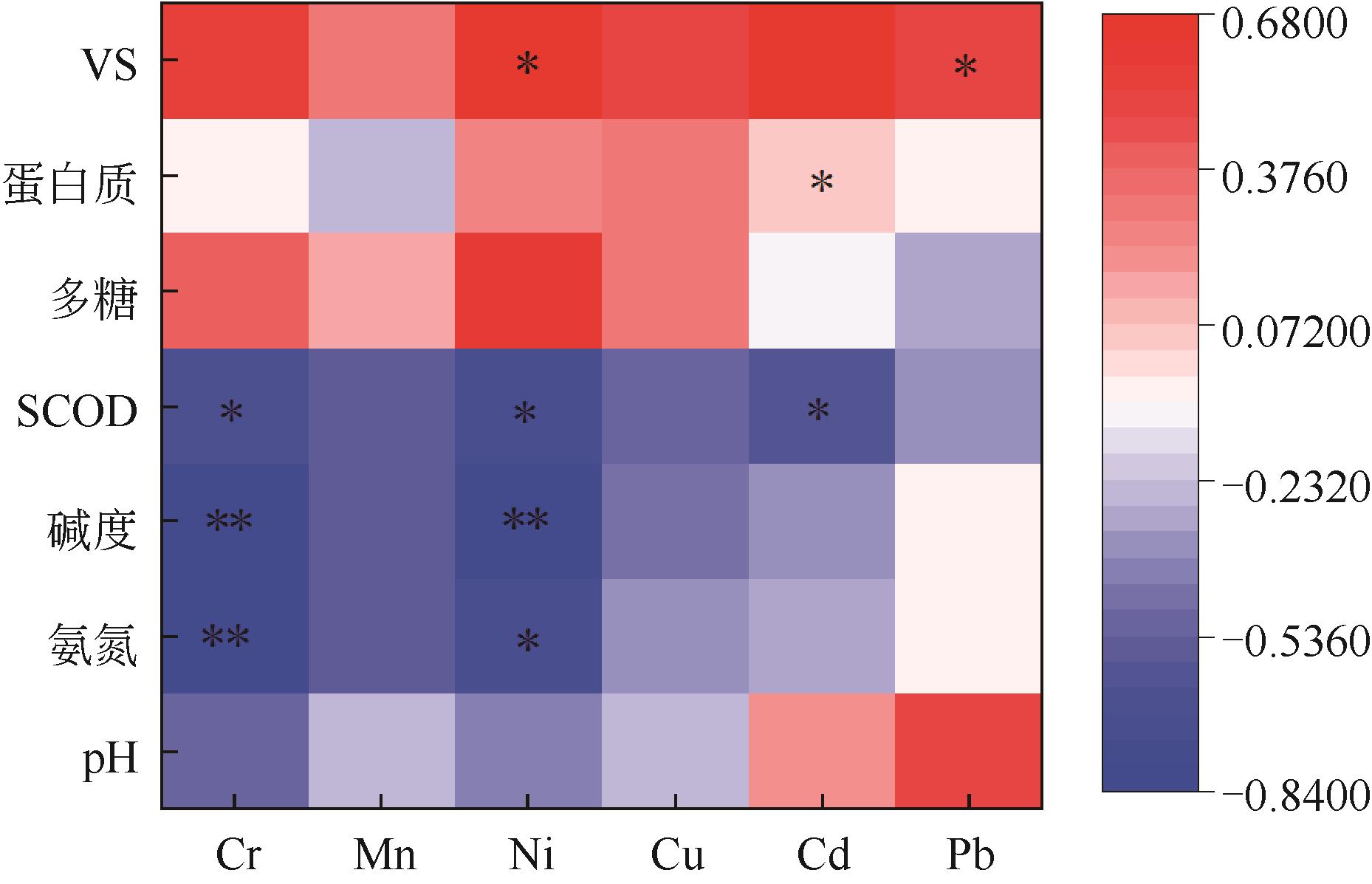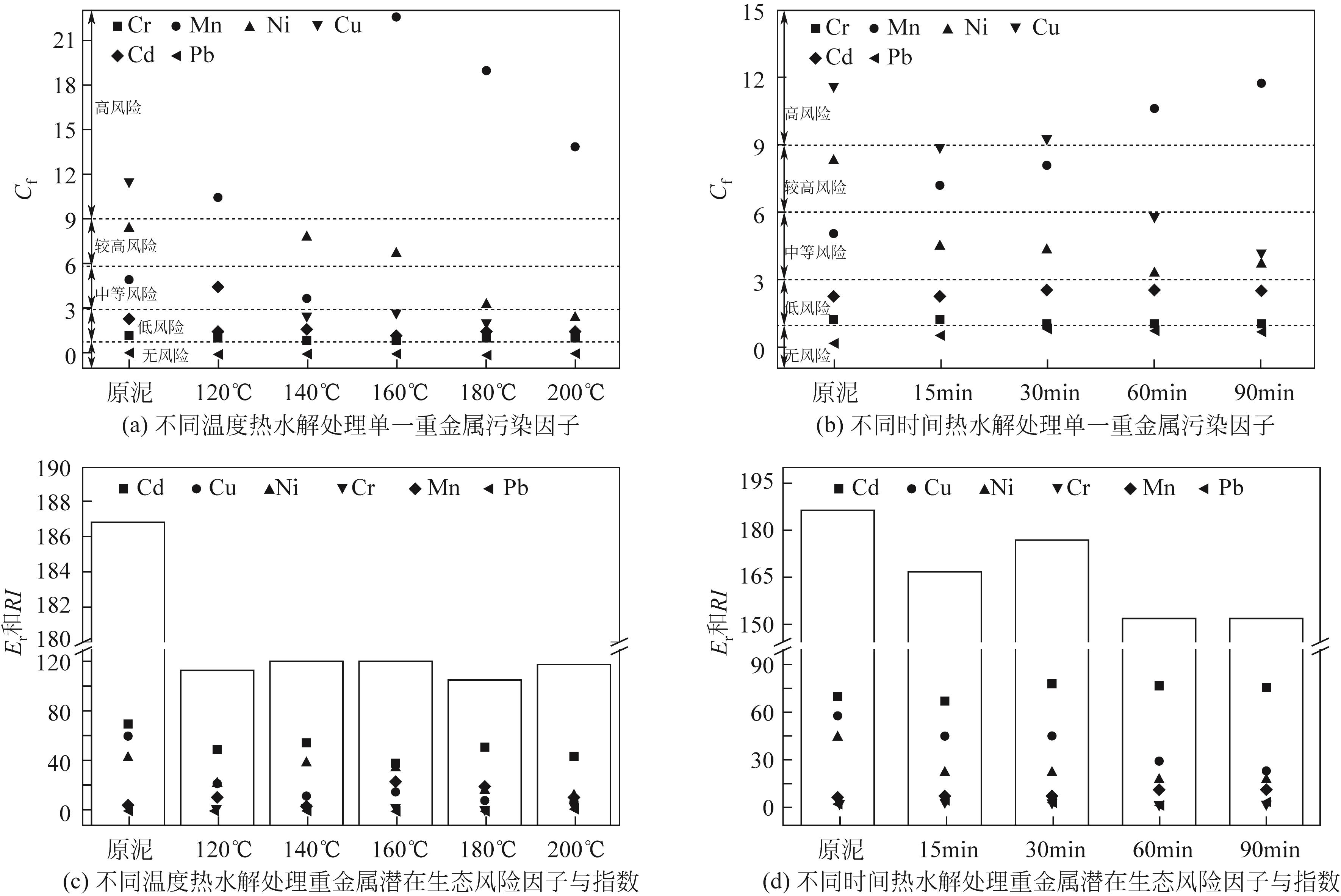化工进展 ›› 2022, Vol. 41 ›› Issue (4): 2216-2225.DOI: 10.16085/j.issn.1000-6613.2021-0921
污泥热水解处理过程重金属的迁移转化与风险评价
付杰1( ), 邱春生1,2, 王晨晨1,2(
), 邱春生1,2, 王晨晨1,2( ), 郑金鑫1, 刘楠楠1,2, 王栋1,2, 王少坡1,2, 孙力平1,2
), 郑金鑫1, 刘楠楠1,2, 王栋1,2, 王少坡1,2, 孙力平1,2
- 1.天津城建大学环境与市政工程学院,天津 300384
2.天津市水质科学与技术重点实验室,天津 300384
-
收稿日期:2021-04-29修回日期:2021-05-27出版日期:2022-04-23发布日期:2022-04-25 -
通讯作者:王晨晨 -
作者简介:付杰(1996—),男,硕士研究生,研究方向为废弃物资源化。E-mail:fujie_2019@163.com 。 -
基金资助:水体污染控制与治理科技重大专项(2017ZX07106001);国家自然科学基金(51908398)
Migration, transformation and risk assessment of heavy metals in municipal sludge treated by thermal hydrolysis
FU Jie1( ), QIU Chunsheng1,2, WANG Chenchen1,2(
), QIU Chunsheng1,2, WANG Chenchen1,2( ), ZHENG Jinxin1, LIU Nannan1,2, WANG Dong1,2, WANG Shaopo1,2, SUN Liping1,2
), ZHENG Jinxin1, LIU Nannan1,2, WANG Dong1,2, WANG Shaopo1,2, SUN Liping1,2
- 1.School of Environmental and Municipal Engineering, Tianjin Chengjian University, Tianjin 300384, China
2.Tianjin Key Laboratory of Aquatic Science and Technology, Tianjin 300384, China
-
Received:2021-04-29Revised:2021-05-27Online:2022-04-23Published:2022-04-25 -
Contact:WANG Chenchen
摘要:
通过分析污泥热水解处理过程中重金属含量与形态的变化,考察不同温度(120~200℃)和不同处理时间(15~90min)对污泥中重金属(Cr、Mn、Ni、Cu、Cd、Pb)迁移转化和环境风险的影响,并对污泥热水解过程中理化参数[挥发性固体(VS)、溶解性蛋白质、多糖、溶解性化学需氧量(SCOD)、碱度、NH4+-N和pH]与重金属生物可利用性变化的相关性进行了分析。结果表明,热水解处理后污泥得到有效破解,部分重金属释放进入液相,但大部分重金属仍残留在固相中。固相中Cr和Mn含量在处理温度较高时(≥180℃)较原泥升高,其他重金属含量均低于原泥。热水解处理后大部分重金属(除Pb外)弱酸提取态占比随处理温度升高和处理时间延长呈下降趋势,且处理后污泥中Cr、Ni、Cu、Cd和Pb残渣态占比明显上升。具有生物有效性重金属含量与污泥NH
中图分类号:
引用本文
付杰, 邱春生, 王晨晨, 郑金鑫, 刘楠楠, 王栋, 王少坡, 孙力平. 污泥热水解处理过程重金属的迁移转化与风险评价[J]. 化工进展, 2022, 41(4): 2216-2225.
FU Jie, QIU Chunsheng, WANG Chenchen, ZHENG Jinxin, LIU Nannan, WANG Dong, WANG Shaopo, SUN Liping. Migration, transformation and risk assessment of heavy metals in municipal sludge treated by thermal hydrolysis[J]. Chemical Industry and Engineering Progress, 2022, 41(4): 2216-2225.
| 理化指标 | 值 |
|---|---|
| TS/g·L-1 | 21.73±0.21 |
| VS/g·L-1 | 11.92±0.21 |
| pH | 7.75±0.01 |
| TCOD/mg·L-1 | 17078.56±55.55 |
| SCOD/mg·L-1 | 125.52±17.23 |
| NH | 19.11±4.34 |
| 溶解性蛋白质/mg·L-1 | 32.603±1.48 |
| 溶解性多糖/mg·L-1 | 12.38±1.64 |
表1 实验用污泥理化性质
| 理化指标 | 值 |
|---|---|
| TS/g·L-1 | 21.73±0.21 |
| VS/g·L-1 | 11.92±0.21 |
| pH | 7.75±0.01 |
| TCOD/mg·L-1 | 17078.56±55.55 |
| SCOD/mg·L-1 | 125.52±17.23 |
| NH | 19.11±4.34 |
| 溶解性蛋白质/mg·L-1 | 32.603±1.48 |
| 溶解性多糖/mg·L-1 | 12.38±1.64 |
| Cf | 重金属污染 风险 | Er | 潜在生态 风险 | RI | 污泥污染风险 |
|---|---|---|---|---|---|
| Cf<1 | 无 | Er<40 | 低 | RI<150 | 低 |
| 1<Cf<3 | 低 | 40<Er<80 | 中等 | 150<RI<300 | 中等 |
| 3<Cf<6 | 中等 | 80<Er<160 | 较高 | 300<RI<600 | 较高 |
| 6<Cf<9 | 较高 | 160<Er<320 | 高 | RI>600 | 高 |
| Cf>9 | 高 | Er>320 | 极高 |
表2 潜在生态风险分类标准[4]
| Cf | 重金属污染 风险 | Er | 潜在生态 风险 | RI | 污泥污染风险 |
|---|---|---|---|---|---|
| Cf<1 | 无 | Er<40 | 低 | RI<150 | 低 |
| 1<Cf<3 | 低 | 40<Er<80 | 中等 | 150<RI<300 | 中等 |
| 3<Cf<6 | 中等 | 80<Er<160 | 较高 | 300<RI<600 | 较高 |
| 6<Cf<9 | 较高 | 160<Er<320 | 高 | RI>600 | 高 |
| Cf>9 | 高 | Er>320 | 极高 |
| 1 | 戴晓虎. 城镇污水处理厂污泥稳定化处理的必要性和迫切性的思考[J]. 给水排水, 2017, 53(12): 1-5. |
| DAI X H. The necessity and urgency of sludge stabilization treatment in municipal sewage treatment plant[J]. Water & Wastewater Engineering, 2017, 53(12): 1-5. | |
| 2 | LIU X X, WANG Y W, GUI C M, et al. Chemical forms and risk assessment of heavy metals in sludge-biochar produced by microwave-induced low temperature pyrolysis[J]. RSC Advances, 2016, 6(104): 101960-101967. |
| 3 | XU Y, ZHANG C S, ZHAO M H, et al. Comparison of bioleaching and electrokinetic remediation processes for removal of heavy metals from wastewater treatment sludge[J]. Chemosphere, 2017, 168: 1152-1157. |
| 4 | ZHEN G Y, LU X Q, KATO H, et al. Overview of pretreatment strategies for enhancing sewage sludge disintegration and subsequent anaerobic digestion: current advances, full-scale application and future perspectives[J]. Renewable and Sustainable Energy Reviews, 2017, 69: 559-577. |
| 5 | YUAN X Z, HUANG H J, ZENG G M, et al. Total concentrations and chemical speciation of heavy metals in liquefaction residues of sewage sludge[J]. Bioresource Technology, 2011, 102(5): 4104-4110. |
| 6 | 解道雷, 孔慈明, 徐龙乾, 等. 城市污泥中重金属存在形态、去除及稳定化研究进展[J]. 化工进展, 2018, 37(1): 330-342. |
| XIE D L, KONG C M, XU L Q, et al. Developments of the speciation, removal and stabilization of heavy metals in municipal sludge[J]. Chemical Industry and Engineering Progress, 2018, 37(1): 330-342. | |
| 7 | 郑金鑫, 邱春生, 王晨晨, 等. Fenton处理对污泥脱水性、重金属形态及生物淋滤效率影响[J]. 化工进展, 2020, 39(2): 805-811. |
| ZHENG J X, QIU C S, WANG C C, et al. Effects of Fenton treatment on sewage sludge dewaterability, heavy metal speciation and leaching efficiency[J]. Chemical Industry and Engineering Progress, 2020, 39(2): 805-811. | |
| 8 | LIN K, KUO J H, LIN C L, et al. Sequential extraction for heavy metal distribution of bottom ash from fluidized bed co-combusted phosphorus-rich sludge under the agglomeration/defluidization process[J]. Waste Management & Research, 2020, 38(2): 122-133. |
| 9 | RAURET G, LÓPEZ-SÁNCHEZ J F, SAHUQUILLO A, et al. Improvement of the BCR three step sequential extraction procedure prior to the certification of new sediment and soil reference materials[J]. Journal of Environmental Monitoring, 1999, 1(1): 57-61. |
| 10 | ZHANG J, TIAN Y, ZHANG J, et al. Distribution and risk assessment of heavy metals in sewage sludge after ozonation[J]. Environmental Science and Pollution Research, 2017, 24(6): 5118-5125. |
| 11 | 陈思思, 杨殿海, 庞维海, 等. 我国剩余污泥厌氧转化的主要影响因素及影响机制研究进展[J]. 化工进展, 2020, 39(4): 1511-1520. |
| CHEN S S, YANG D H, PANG W H, et al. Main influencing factors and mechanisms of anaerobic transformation of excess sludge in China[J]. Chemical Industry and Engineering Progress, 2020, 39(4): 1511-1520. | |
| 12 | 卓杨, 韩芸, 程瑶, 等. 高含固污泥水热预处理中碳、氮、磷、硫转化规律[J]. 环境科学, 2015, 36(3): 1006-1012. |
| ZHUO Y, HAN Y, CHEN Y, et al. Transformation characteristics of carbon, nitrogen, phosphorus and sulfur during thermal hydrolysis pretreatment of sludge with high solid content[J]. Environmental Science, 2015, 36(3): 1006-1012. | |
| 13 | ZHENG J X, QIU C S, WANG C C, et al. Influence of thermal hydrolysis treatment on chemical speciation and bioleaching behavior of heavy metals in the sewage sludge[J]. Water Science and Technology, 2021, 83(2): 372-380. |
| 14 | 孙雪萍, 王安亭, 李新豪, 等. 热水解法处理污泥过程中重金属的迁移规律[J]. 中国给水排水, 2010, 26(17): 66-68, 72. |
| SUN X P, WANG A T, LI X H, et al. Migration of heavy metals in sludge treatment by thermal hydrolysis process[J]. China Water & Wastewater, 2010, 26(17): 66-68, 72. | |
| 15 | 王兴栋, 林景江, 李智伟, 等. 水热处理时间对污泥中氮磷钾及重金属迁移的影响[J]. 环境科学, 2016, 37(3): 1048-1054. |
| WANG X D, LIN J J, LI Z W, et al. Effects of hydrothermal treatment time on the transformations of N, P, K and heavy metals in sewage sludge[J]. Environmental Science, 2016, 37(3): 1048-1054. | |
| 16 | WU H M, LI M, ZHANG L, et al. Research on the stability of heavy metals (Cu, Zn) in excess sludge with the pretreatment of thermal hydrolysis[J]. Water Science and Technology, 2016, 73(4): 890-898. |
| 17 | 国家环境保护总局《水和废水监测分析方法》编委会. 水和废水监测分析方法[M]. 4版. 北京: 中国环境科学出版社, 2002. |
| State Environmental Protection Administration Determination methods for examination of water and wastewater Editorial Board. Determination methods for examination of water and wastewater[M]. 4th ed. Beijing: China Environmental Science Press, 2002. | |
| 18 | FR/OLUND B, GRIEBE T, NIELSEN P H. Enzymatic activity in the activated-sludge floc matrix[J]. Applied Microbiology and Biotechnology, 1995, 43(4): 755-761. |
| 19 | DUBOIS M, GILLES K A, HAMILTON J K, et al. Colorimetric method for determination of sugars and related substances[J]. Analytical Chemistry, 1956, 28(3): 350-356. |
| 20 | MARCHIORETTO M M, BRUNING H, RULKENS W. Heavy metals precipitation in sewage sludge[J]. Separation Science and Technology, 2005, 40(16): 3393-3405. |
| 21 | HAKANSON L. An ecological risk index for aquatic pollution control—A sedimentological approach[J]. Water Research, 1980, 14(8): 975-1001. |
| 22 | HUANG H J, YUAN X Z, ZENG G M, et al. Quantitative evaluation of heavy metals’ pollution hazards in liquefaction residues of sewage sludge[J]. Bioresource Technology, 2011, 102(22): 10346-10351. |
| 23 | ZHANG Q, ZHANG L, SANG W J, et al. Chemical speciation of heavy metals in excess sludge treatment by thermal hydrolysis and anaerobic digestion process[J]. Desalination and Water Treatment, 2016, 57(27): 12770-12776. |
| 24 | 乔玮, 王伟, 黎攀, 等. 城市污水污泥微波热水解特性研究[J]. 环境科学, 2008, 29(1): 152-157. |
| QIAO W, WANG W, LI P, et al. Sewage sludge microwave thermal hydrolysis process[J]. Environment Science, 2008, 29(1): 152-157. | |
| 25 | JEONG S Y, CHANG S W, NGO H H, et al. Influence of thermal hydrolysis pretreatment on physicochemical properties and anaerobic biodegradability of waste activated sludge with different solids content[J]. Waste Management, 2019, 85: 214-221. |
| 26 | ZHANG D, FENG Y M, HUANG H B, et al. Recalcitrant dissolved organic nitrogen formation in thermal hydrolysis pretreatment of municipal sludge[J]. Environment International, 2020, 138: 105629. |
| 27 | YOSHIDA T, ANTAL M J. Sewage sludge carbonization for terra preta applications[J]. Energy & Fuels, 2009, 23(11): 5454-5459. |
| 28 | WEI L L, LI J J, XUE M, et al. Adsorption behaviors of Cu2+, Zn2+ and Cd2+ onto proteins, humic acid, and polysaccharides extracted from sludge EPS: sorption properties and mechanisms[J]. Bioresource Technology, 2019, 291: 121868. |
| 29 | 于贺, 邱春生, 王晨晨, 等. Fenton预处理对城市污泥重金属形态及生物淋滤溶出影响[J]. 环境工程学报, 2019, 13(3): 725-731. |
| YU H, QIU C S, WANG C C, et al. Influence of Fenton pretreatment on heavy metal speciation and bioleaching efficiency in municipal sludge[J]. Chinese Journal of Environmental Engineering, 2019, 13(3): 725-731. | |
| 30 | WOO S, YUM S, JUNG J H, et al. Heavy metal-induced differential gene expression of metallothionein in Javanese medaka, Oryzias javanicus [J]. Marine Biotechnology, 2006, 8(6): 654-662. |
| 31 | ADAM V, PETRLOVA J, POTESIL D, et al. Study of metallothionein modified electrode surface behavior in the presence of heavy metal ions-biosensor[J]. Electroanalysis, 2005, 17(18): 1649-1657. |
| 32 | RUDD T, STERRITT R M, LESTER J N. Complexation of heavy metals by extracellular polymers in the activated sludge process [J]. Journal (Water Pollution Control Federation), 1984, 56(12): 1260-1268. |
| 33 | 甘莉, 刘贺琴, 王清萍, 等. 氧化亚铁硫杆菌生物浸出污泥中的重金属离子[J]. 中国环境科学, 2014, 34(10): 2617-2623. |
| GAN L, LIU H Q, WANG Q P, et al. Bioleaching of heavy metals in sewage sludge using Acidithiobacillus ferrooxidans [J]. China Environmental Science, 2014, 34(10): 2617-2623. | |
| 34 | 朱萍, 李晓晨, 马海涛, 等. 污泥中重金属形态分布与可浸出性的相关性研究[J]. 河海大学学报(自然科学版), 2007, 35(2): 121-124. |
| ZHU P, LI X C, MA H T, et al. Correlation between chemical forms and leachability of heavy metals in sludge samples[J]. Journal of Hohai University(Natural Sciences), 2007, 35(2): 121-124. | |
| 35 | ZHENG X R, LIU Y Q, HUANG J M, et al. The influence of variables on the bioavailability of heavy metals during the anaerobic digestion of swine manure[J]. Ecotoxicology and Environmental Safety, 2020, 195: 110457. |
| [1] | 李世霖, 胡景泽, 王毅霖, 王庆吉, 邵磊. 电渗析分离提取高值组分的研究进展[J]. 化工进展, 2023, 42(S1): 420-429. |
| [2] | 许春树, 姚庆达, 梁永贤, 周华龙. 共价有机框架材料功能化策略及其对Hg(Ⅱ)和Cr(Ⅵ)的吸附性能研究进展[J]. 化工进展, 2023, 42(S1): 461-478. |
| [3] | 李卫华, 于倩雯, 尹俊权, 吴寅凯, 孙英杰, 王琰, 王华伟, 杨玉飞, 龙於洋, 黄启飞, 葛燕辰, 何依洋, 赵灵燕. 酸雨环境下填埋飞灰吨袋破损后重金属的溶出行为[J]. 化工进展, 2023, 42(9): 4917-4928. |
| [4] | 李志远, 黄亚继, 赵佳琪, 于梦竹, 朱志成, 程好强, 时浩, 王圣. 污泥与聚氯乙烯共热解重金属特性[J]. 化工进展, 2023, 42(9): 4947-4956. |
| [5] | 史天茜, 石永辉, 武新颖, 张益豪, 秦哲, 赵春霞, 路达. Fe2+对厌氧氨氧化EGSB反应器运行性能的影响[J]. 化工进展, 2023, 42(9): 5003-5010. |
| [6] | 杨子育, 朱玲, 王文龙, 于超凡, 桑义敏. 阴燃法处理含油污泥的研究及应用进展[J]. 化工进展, 2023, 42(7): 3760-3769. |
| [7] | 张杉, 仲兆平, 杨宇轩, 杜浩然, 李骞. 磷酸盐改性高岭土对生活垃圾热解过程中重金属的富集[J]. 化工进展, 2023, 42(7): 3893-3903. |
| [8] | 郑昕, 贾里, 王彦霖, 张靖超, 陈世虎, 乔晓磊, 樊保国. 污泥与煤泥混烧对重金属固留特性的影响[J]. 化工进展, 2023, 42(6): 3233-3241. |
| [9] | 修浩然, 王云刚, 白彦渊, 邹立, 刘阳. 准东煤/市政污泥混燃燃烧特性及灰熔融行为分析[J]. 化工进展, 2023, 42(6): 3242-3252. |
| [10] | 詹咏, 王慧, 韦婷婷, 朱星宇, 王先恺, 陈思思, 董滨. Mn2+强化臭氧调理对生物处理工艺的污泥原位减量效果[J]. 化工进展, 2023, 42(6): 3253-3260. |
| [11] | 庄捷, 薛锦辉, 赵斌成, 张文艺. 猪粪厌氧消化进程中重金属与腐殖质的有机结合机制[J]. 化工进展, 2023, 42(6): 3281-3291. |
| [12] | 李若琳, 何少林, 苑宏英, 刘伯约, 纪冬丽, 宋阳, 刘博, 余绩庆, 徐英俊. 原位热解对油页岩物性及地下水水质影响探索[J]. 化工进展, 2023, 42(6): 3309-3318. |
| [13] | 李卫华, 吴寅凯, 孙英杰, 尹俊权, 辛明学, 赵友杰. 垃圾焚烧飞灰重金属毒性浸出评价方法研究进展[J]. 化工进展, 2023, 42(5): 2666-2677. |
| [14] | 常占坤, 张弛, 苏冰琴, 张聪政, 王健, 权晓慧. H2S气态基质对污泥生物沥滤处理效能的影响[J]. 化工进展, 2023, 42(5): 2733-2743. |
| [15] | 杨自强, 李风海, 郭卫杰, 马名杰, 赵薇. 市政污泥热处理过程中磷迁移转化的研究进展[J]. 化工进展, 2023, 42(4): 2081-2090. |
| 阅读次数 | ||||||
|
全文 |
|
|||||
|
摘要 |
|
|||||

